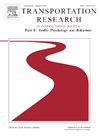Modelling sidewalk safety perceptions of pedestrians accessing bus stops and uncovering its role in shaping bus ridership: An empirical investigation
IF 3.5
2区 工程技术
Q1 PSYCHOLOGY, APPLIED
Transportation Research Part F-Traffic Psychology and Behaviour
Pub Date : 2025-06-12
DOI:10.1016/j.trf.2025.06.008
引用次数: 0
Abstract
Measuring personal safety perception is a complex task, as it encompasses a multi-faceted array of factors. This study explores the factors influencing the perceived safety of pedestrians while accessing bus stops via sidewalks and develops a comprehensive measurement model for sidewalk safety perception. Additionally, the study investigates potential links between sidewalk safety perceptions and bus ridership by applying Structural Equation Modelling (SEM). Data were collected from 568 personal interviews conducted across various Indian cities, focusing on pedestrians’ perceptions of safety while accessing bus stops. Perceived safety was conceptualized as a latent construct, with second-order confirmatory factor analysis identifying three primary dimensions: “Safety from Sidewalk Infrastructure”, “Safety from Other User Behavior” and “Safety from Sidewalk Maintenance and Management”. These three latent constructs collectively represent the overall safety perception of sidewalks in the context of bus stop access. Further analysis found that most bus users prefer a minimum sidewalk width of 1.5–2 m and an increased minimum width of 2–4 m near bus stops. The findings offer valuable insights into the intricate factors shaping pedestrian safety perceptions and provide a robust framework for enhancing sidewalk conditions to promote safer and more accessible public transit usage.
行人进入公交车站的人行道安全感知模型及其在公交客流量塑造中的作用:一项实证调查
测量个人安全感知是一项复杂的任务,因为它包含多方面的因素。本研究探讨了行人通过人行道进入公交车站时安全感知的影响因素,建立了行人通过人行道安全感知的综合测量模型。此外,本研究还通过结构方程模型(SEM)探讨了人行道安全感知与公交客流量之间的潜在联系。数据收集自在印度各个城市进行的568次个人访谈,重点关注行人在访问公交车站时对安全的看法。感知安全被定义为一个潜在的概念,二级验证性因子分析确定了三个主要维度:“人行道基础设施安全”、“其他用户行为安全”和“人行道维护和管理安全”。这三个潜在构念共同代表了公交车站通道中人行道的整体安全感知。进一步分析发现,大多数公交用户更喜欢1.5-2米的最小人行道宽度,并在公交车站附近增加2-4米的最小宽度。研究结果对影响行人安全认知的复杂因素提供了有价值的见解,并为改善人行道条件提供了强有力的框架,以促进更安全、更便捷的公共交通使用。
本文章由计算机程序翻译,如有差异,请以英文原文为准。
求助全文
约1分钟内获得全文
求助全文
来源期刊
CiteScore
7.60
自引率
14.60%
发文量
239
审稿时长
71 days
期刊介绍:
Transportation Research Part F: Traffic Psychology and Behaviour focuses on the behavioural and psychological aspects of traffic and transport. The aim of the journal is to enhance theory development, improve the quality of empirical studies and to stimulate the application of research findings in practice. TRF provides a focus and a means of communication for the considerable amount of research activities that are now being carried out in this field. The journal provides a forum for transportation researchers, psychologists, ergonomists, engineers and policy-makers with an interest in traffic and transport psychology.

 求助内容:
求助内容: 应助结果提醒方式:
应助结果提醒方式:


